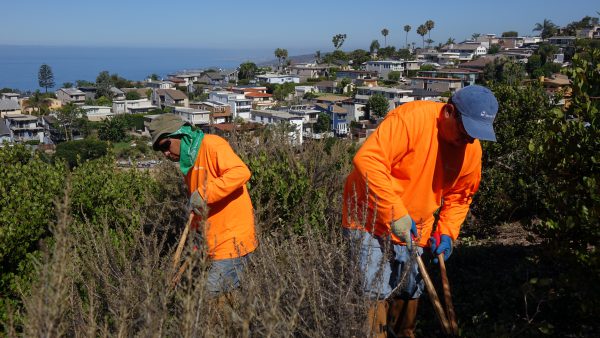
By Breeana Greenberg, Special to the Independent
The Laguna Beach Fire Department held a workshop on Tuesday to gather public input on a wildfire fuel modification project to thin or remove dead, invasive, and non-native plants in South Laguna.
To protect homes from wildfires, the project will minimize fuel for wildfires, which are occurring more frequently and more severely.
“The devastation from wildfires this year, through the first half of the year, is running at more than two times what it was last year when we lost more than four percent of the entire state of California,” Matt Lawson, chair of the emergency and disaster preparedness committee said. “We could easily be on track to lose something approaching another 10 percent this year.”
City officials estimate that the permitting process will be completed by the end of this year, starting the development of the fuel mitigation zone in early 2022, Wildland Fire Defense and Fuels Program Manager Mike Rohde said. The project is estimated to take two years to complete.
Crews will be clearing vegetation by hand, supervised by Laguna Beach Fire staff and ecologists from the Laguna Canyon Foundation. The clearing will occur from 8 a.m. to 5 p.m. Monday through Friday.
“The goal of this whole project isn’t to completely stop the spread of a fire as it may be moving into the City,” Fuels Management Grants Coordinator Pat Antrim said. “The goal is actually to reduce the fire intensity of about 75%, reduce the ember production of the flames as they may be moving down the slopes or up the slopes as the case may be, and provide an environment that firefighters can actually be effective in suppressing the fire itself.”
In South Laguna, one zone will target an area of almost eight acres from Ceanothus Drive to Eagle Rock Way, helping protect the headquarters of the South Coast Water District. Another zone would trim back 12.5 acres from Eagle Rock Way to about 10th street, Antrim explained.
Crews will begin thinning or removing plants about 30 feet from the end of properties’ backyards and work their way out 100 feet.
“The treatment on the hillside is very selective,” Rohde explained. “With our agreement with the Coastal Commission, the U.S. Fish and Wildlife Service and the California Department of Fish and Wildlife, we’ve come up with a hierarchy of plants that are removed in a priority basis, based on the value of individual plant species to the overall habitat we’re trying to protect.”
Non-native, invasive plants would be completely cleared first. If crews are able to achieve the goal of 50% reduction in wildfire fuel by only removing weeds and annuals, they will stop there, explained Rohde. After removing non-native and invasive plants, if further thinning or removal needs to occur, crews will follow the hierarchy to remove the least valuable plants first.
“There’s a lot of questions about, do we denude the slopes, do we take everything off the slopes, and we definitely do not,” Antrim said. “Our permits will only allow us to reduce about 50% of the existing fuels that are on the slopes. So non-native vegetation is removed from the site completely. Native vegetation will be cut into mulch and spread on the slopes to aid in erosion control. Our goal is to not have bare soil, so that if and when it does ever rain, we won’t be dealing too much with erosion issues.”
“The City maintains the sites after construction, up to three times a year to make sure that we maintain removal of weeds,” Rohde said. “Weeds are conducive to fire spread, cause contamination of native habitat with non-native species, and it’s a high priority for the City to maintain those areas weed free as we maintain those sites into perpetuity.”
The project is funded through a $1 million grant partnership with California Department of Natural Resources and the Laguna Canyon Foundation.
The fuel modification zone is necessary to ensure that the City complies with State requirements to receive future disaster relief funding.
Resident Louis Weil noted that trees provide residents with privacy and asked that they remain untouched by the project. In anticipation of the project, residents were contacted and asked to consider granting access to city work crews. The City plans on working closely with property owners to make sure that each property’s needs are addressed.
“We’re very thankful for the permission to access their property to make this community-wide benefit happen,” Rohde said. “And to that end, we work very closely with the property owners to make sure they’re satisfied with the outcomes.”
“What we’re seeing happening up north today is likely to be very visible down here within the next 30, 60, 90 days here in Southern California,” Lawson said. “We just need to do everything we can as quickly as we can to preserve this paradise that we call Laguna Beach, lest it become paradise like Paradise.”
The California Environmental Quality Act process will end with a public hearing at the Planning Commission. The coastal permitting process will also be discussed at the planning commission meeting. This meeting has yet to be scheduled but is estimated to be held in October or November.





I live in south Laguna. I don’t understand how getting rid of non-native weeds reduce fire risks in our hills. How is it even possible to rid our hills or non-native weeds? Goats seem a lot efficient in creating fire breaks and I doubt it would cost the City $1M to do that. This is Mission Impossible with a high price tag. SLCA has no standing in criticizing the city for not doing appraisals on purchasing lots for public uses when they don’t bat an eye on doing something costly without any scientific basis. It is getting harder every year to get fire insurance coverage if they haven’t noticed.
Silly. Why are we spending a Million Dollars on surgical removal of Invasives when our LB Goats are starving? Check the LB City Budget!